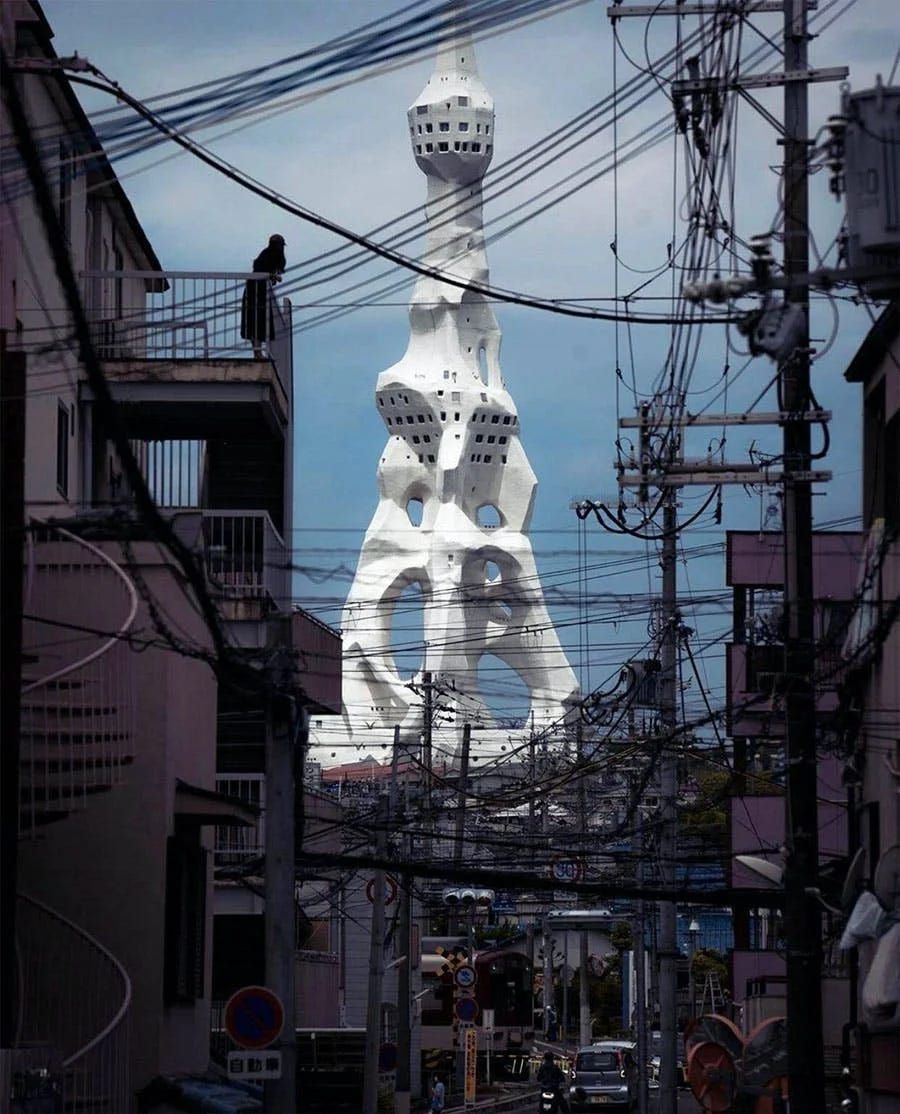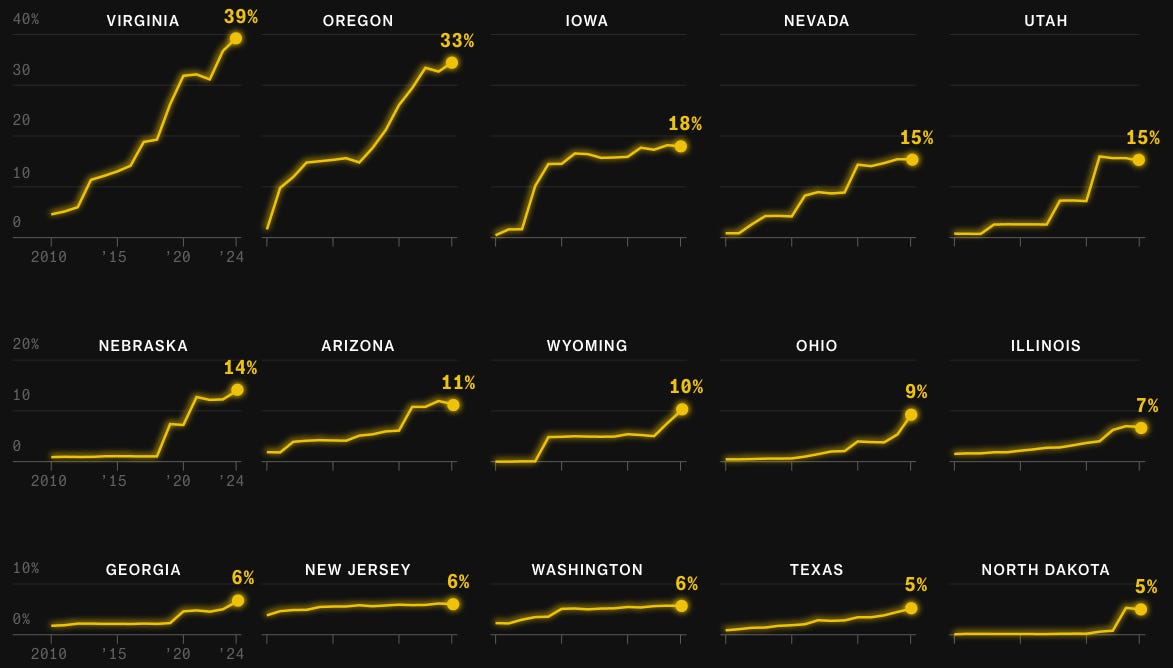Reading List 10/04/2025
Boeing’s 737 replacement, parking lot investments, a deflected hurricane, opinions on nuclear power, and more.
Welcome to the reading list, a weekly roundup of news and links related to buildings, infrastructure, and industrial technology. This week we look at Boeing’s 737 replacement, parking lot investments, a deflected hurricane, opinions on nuclear power, and more. Roughly 2/3rds of the reading list is paywalled, so for full access become a paid subscriber.
No essay this week, but I’m finishing up an essay about the rise in pedestrians killed in motor vehicle accidents that will be out next week.
Thanks to those of you who were able to come out to the book launch party last Friday!
Boeing’s 737 replacement
Boeing is finally working on a new clean-sheet aircraft to replace the aging and beleaguered 737 MAX. This is a big deal, not just because single aisle, twin-engine aircraft (of which the 737 is a type) sell in larger volumes by far than any other aircraft, but because if completed it will be the first clean-sheet aircraft Boeing has developed since the 787, which first flew in 2009. Via the Wall Street Journal ($):
Earlier this year, Chief Executive Kelly Ortberg met with officials from Rolls-Royce Holdings in the U.K., two of the people said, where they discussed a new engine for the aircraft. Ortberg appointed a new senior product chief in Boeing’s commercial plane business, whose prior role was developing a new type of aircraft.
Boeing has also been designing the flight deck of a new narrow-body aircraft, according to a person familiar with the plans.
This new aircraft is in early-stage development and plans are still taking shape, some of the people said.
Boeing’s plans represent a shift for the company, which had put some new aircraft development work on the back burner while it navigated multiple challenges. They are also a sign that the company is betting that a cutting-edge plane design could power its business for the next few decades.
Ortberg hasn’t publicly detailed any plans for a 737 successor. He has consistently said that fixing Boeing’s long-running quality and manufacturing problems, and shoring up its balance sheet, are his priorities.
Developing a new aircraft can typically only be justified when it comes with a substantial fuel savings, so it’ll be interesting to see what strategies Boeing pursues to try to achieve that.
Ticketing a Waymo
We’ve gotten used to hearing about the confabulations and errors that LLMs make, and Tesla is often in the news for some sort of unfortunate Full Self Drive error. Waymo’s self-driving cars appear to be incredibly safe in general (most of their accidents seem to be the fault of other cars), but I guess it shouldn’t be surprising that they also make the occasional error. Of those errors, some percentage of them will violate traffic laws, and some percentage of those violations will be observed by the police, who will then pull the car over. From the Guardian:
During a DUI enforcement operation, officers in San Bruno pulled over a car without anyone behind the wheel after the autonomous vehicle made an illegal U-turn at a light. A post by the San Bruno police department on Saturday shows an officer looking into a Waymo – the leading autonomous ride-hailing vehicle in the San Francisco Bay Area – after stopping the signature white car.
“Since there was no human driver, a ticket couldn’t be issued (our citation books don’t have a box for “robot”),” reads the post.
The department said that it had alerted Waymo of the glitch, and that “hopefully the reprogramming will keep it from making any more illegal moves”.
In a statement, Waymo said that the company’s autonomous driving system, the Waymo Driver, “is designed to respect the rules of the road.
“We are looking into this situation and are committed to improving road safety through our ongoing learnings and experience,” reads a statement sent to the Guardian.
Apparently this isn’t the first time a Waymo has been pulled over by the police.
This actually made me wonder what Waymo’s policy is for handling police interactions: apparently, it’s to flag a remote operator, who can then interact with the police via the speakers.
Parking lot investments
The enormous volume of data center construction in the US is also driving demand for all other sorts of goods and services. Electricity is one obvious one, as are the semiconductor chips that go inside the facilities. Here’s one I hadn’t clocked: empty lots to store construction materials while the facilities are being built. These lots are known as “industrial outdoor storage” (IOS), and demand for them is apparently booming: Via the New York Times:
Since 2021, institutional investors have poured more than $4.7 billion in the sector, said Matt Hunsucker, principal at the development firm Mackenan and founder of IOS List, an industry newsletter. Those same investors, which include pension funds, mutual funds, large banks and asset managers, accounted for less than $600 million of total investments in IOS properties from 2015 to 2020, he said.
The new wave of investments has come as Wall Street races to profit from A.I. in whatever way it can. Financial giants like Blackstone have invested hundreds of billions not only in data centers but also the construction firms that build the centers and power plants that supply the electricity needed to run them.
Data centers have created “tremendous demand for IOS use, every bit as much as traditional infrastructure work like bridges, tunnels and roads,” said Leo Addimando, managing partner of Alterra.
Data center electricity demand by state
We recently looked at trends in wholesale electricity prices - the prices utilities and other large consumers of electricities pay for power on power markets. Bloomberg also has a piece on trends in wholesale electricity prices, associating them with increase in data center electricity demand. Per the article, “Of the nodes that recorded price increases, more than 70% are located within 50 miles of significant data center activity.”
I don’t find this particularly convincing, but the article also has a very interesting chart showing which states have the greatest demand in electricity from data centers. Demand is (unsurprisingly) highest in Virginia, where data centers make up 39%(!) of electricity demand, but it’s also surprisingly high in Oregon (Oregon ranks 27th by population, but 9th in number of data centers, according to Data Center Map). Assuming this is accurate, perhaps this is why Oregon has so much power capacity in the interconnection queue.



